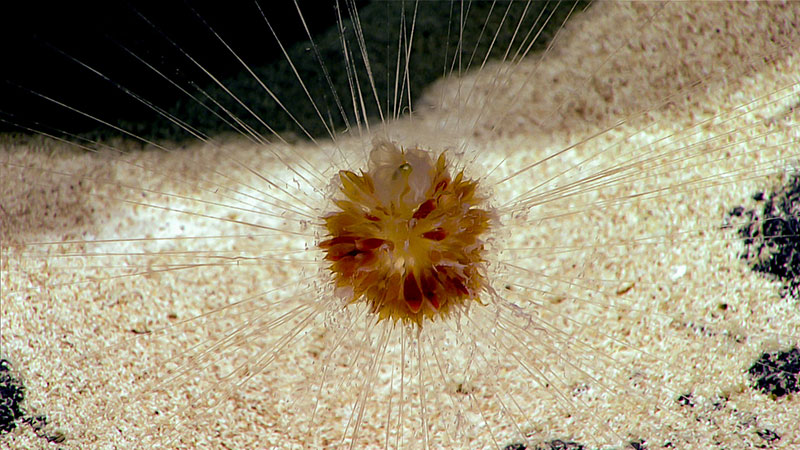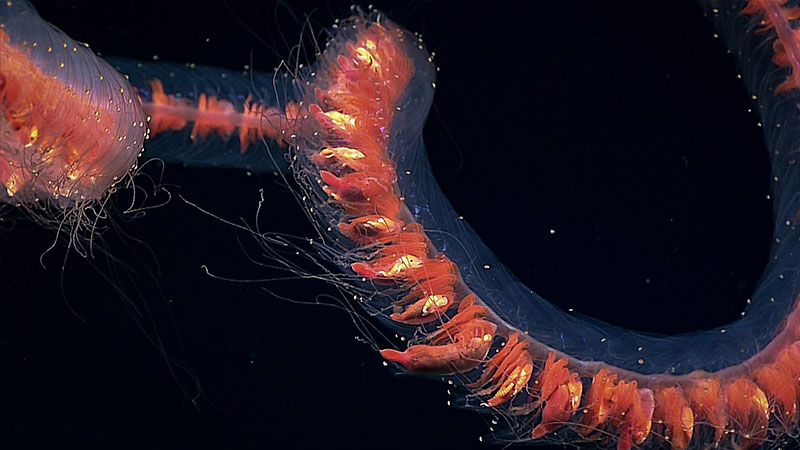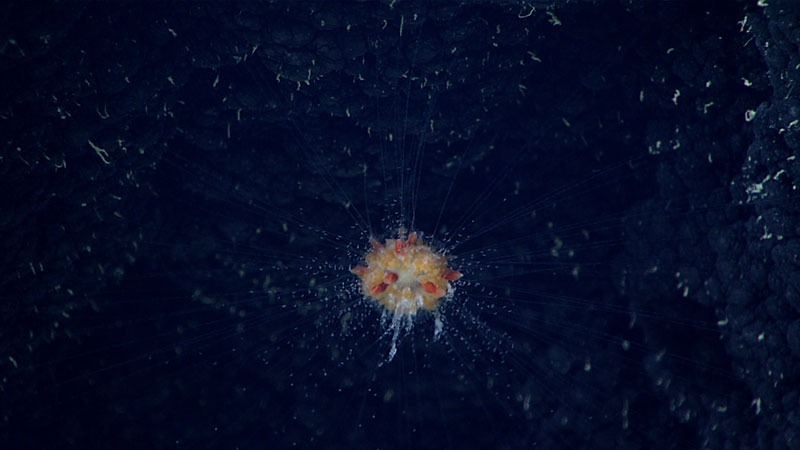
by Scott C. France, University of Louisiana at Lafayette
July 30, 2017

This dandelion siphonophore is the first we observed on this expedition. Found at approximately 2,530 meters (8,300 feet) depth, we were able to see the feeding tentacles extended around the animal like a spider web as well as the pulsating nectophores, found just below and around the “float,” which helped to keep the central body suspended. Image courtesy of the NOAA Office of Ocean Exploration and Research, 2017 Laulima O Ka Moana. Download larger version (jpg, 265 KB).
One of the exciting parts of being involved in NOAA Ship Okeanos Explorer expedition dives into the deep sea is the opportunity to see strange and unusual animals living in their natural habitat. Among the most unusual is the so-called “dandelion animal.”
On the rare occasions we encounter these invertebrates, they appear from a distance as a pulsating, faintly glowing, orange-yellow ball that seems to hover just above the bottom. But as the remotely operated vehicle (ROV) and camera move closer, we get a better view. We can see it is not exactly hovering. It appears tethered to the bottom by guy-wires, like a hot-air balloon that is being inflated prior to lift-off. What is this beast?
In scientific terms, dandelion animals are physonect siphonophores. They are a type of pelagic colonial Hydrozoa. Those of you who regularly watch the Okeanos Explorer live video streams will be familiar with hydrozoans. They are a type of cnidarian—thus closely related to corals, sea anemones, and jellyfish.
Hydrozoans have a great diversity of morphologies and lifestyles. Some are solitary, such as the freshwater Hydra that is commonly studied in labs and classrooms. Others that we commonly see during midwater transects look like very small jellyfish. Many form colonies. Some colonies look like branching fans, many like little bushes, and others grow as fuzz on the shells of hermit crabs (Snail Fur, Hydractinia echinata).

This intact deepwater siphonophore was observed during the Discovering the Deep: Exploring Remote Pacific Marine Protected Areas expedition. Although they may appear to be a single organism, these giant siphonophores are actually comprised of a colony of individual hydrozoans, each specialized for different functions such as swimming, feeding, and reproduction. Image courtesy of the NOAA Office of Ocean Exploration and Research, Discovering the Deep: Exploring Remote Pacific MPAs. Download larger version (jpg, 1.1 MB).
The Order Siphonophorae are colonial hydrozoans that are specialized to live in the water column. This order is divided into three suborders: the Calycophorae, the Cystonectae, and the Physonectae. Probably the best-known example of a siphonophore is a cystonect, the Portuguese Man-o-War, Physalia physalis.
The dandelion animal is in a different suborder—Physonectae. The dandelion animal is further classified in the family Rhodaliidae, which are unusual and unique siphonophores because they anchor themselves to the seafloor using their tentacles. In the video below you can see a more “typical” physonect siphonophore swimming in the water column. This colony has the same features as the rhodaliids, but is much more elongated.
On March 14, during the sixth dive of the expedition, this intact deepwater siphonophore was observed. Although they may appear to be a single organism, these giant siphonophores are actually comprised of a colony of individual hydrozoans, each specialized for different functions such as swimming, feeding, and reproduction. Video courtesy of the NOAA Office of Ocean Exploration and Research, Discovering the Deep: Exploring Remote Pacific MPAs. Download larger version (mp4, 20.0 MB).
One way to understand the morphology (physical shape) of physonect siphonophores, including the dandelion animal, is to look at how they develop. From the egg hatches a larva that can be described simply as a long oval sac that has a mouth at one end. This larva will continue to elongate as it grows. So far this is similar to the development of the Hydra. However, one end of the Hydra will attach to a surface and the opposite mouth-end becomes surrounded by tentacles.
As the dandelion animal larva elongates, the end away from the mouth will fold back upon itself and form a gas-filled float, or pneumatophore, at the upper end of the colony (the whitish upper sphere in the images). The remainder of the larva forms a sort of stem from which the colony arises. In the region below the pneumatophore, the stem will begin to bud zooids. These will develop into nectophores, which are tiny medusa (like attached jellyfish) that propel the entire colony through the water (the cystonect siphonophores do not have these structures). In the video below, you can see the pulsating nectophores in action.
A rare encounter with a swimming dandelion siphonophore on Dive 17 at Farallon de Medinilla. This dandelion is actually comprised of many individuals that all work together with some protecting the colony, some catching food, some reproducing, etc. These animals are usually observed anchored to seafloor. Video courtesy of the NOAA Office of Ocean Exploration and Research, 2016 Deepwater Exploration of the Marianas. Download larger version.
Past the nectophores, the stem gives rise to a variety of zooids, some specialized for feeding, some for reproduction, and some for defense. In the video below, the longer brown structures that look like wriggling worms are the feeding gastrozooids (a zooid with a mouth and digestive cavity). Arising from the hidden bases of the gastrozooids are tentacles that serve to both anchor the colony to the seafloor and capture prey. The gastrozooids can greatly elongate. It is thought they extend to press their mouth over the strung-out tentacles to ingest captured prey, rather than reeling the tentacles in as the pelagic colonies do.
This potentially new species of dandelion siphonophore, from the family Rhodalidae, was imaged using its tentacles to attach to the iron-manganese encrusted rocks in the deep slopes of Rose Atoll. VVideo courtesy of the NOAA Office of Ocean Exploration and Research, 2017 American Samoa. Download larger version (mp4, 18.4 MB).
The name “dandelion animal” is actually associated with a specific species of Rhodaliidae, Thermopalia taraxaca, which was a siphonophore species discovered living near deep-sea hydrothermal vents. To the first biologists who saw them, spread above the seafloor in aggregations of individual colonies, the suspended spheres of the colonies reminded them of the spent heads of the common dandelion flower. The etymology of Thermopalia taraxaca is essentially “dandelion from the hot, sea-vent hole” (the scientific name of the common dandelion flower is Taraxacum officinale). It should be noted that there are at least fifteen known species of rhodaliid siphonophores. Therefore, we may not be seeing the dandelion animal Thermopalia taraxaca, but perhaps a different or even an undescribed species.
You can learn more about the amazing siphonophores at http://www.siphonophores.org .

A notable cnidarian observed during Dive 14 of this expedition was a red-orange benthic “dandelion” siphonophore seen on the underside of a large basalt boulder. Image courtesy of the NOAA Office of Ocean Exploration and Research, 2017 Laulima O Ka Moana. Download larger version (jpg, 776 KB).